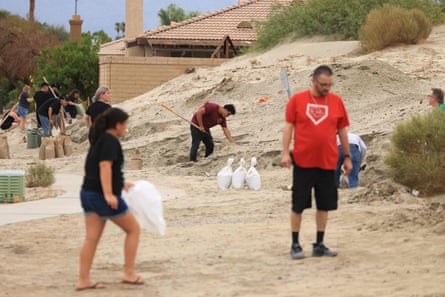Hurricane Hilary was closing in on southern California on Sunday as federal emergency officials, stretched by deadly wildfires in Maui and Washington state, warned of a “serious impact and threat”.
Despite weakening to a category 1 cyclone, the storm was still packing winds of 80mph as it approached Mexico and the south-western US, with “catastrophic” flooding expected to follow landfall.
Evacuations were under way in many areas, including Baja California and in the mountains and foothills of San Bernardino county, in California. Experts predicted life-threatening floods and landslides, while some desert regions could receive two to three years’ worth of rain in three days.
“People need to take the storm seriously, they need to listen to their local officials, and they need to make sure that they’re not putting themselves in harm’s way as the storm passes through,” Deanne Criswell, administrator of the federal emergency management agency (Fema), told CNN’s State of the Union.

“Hurricane Hilary is going to be a serious impact and threat to southern California.”
It would be the first tropical storm to hit the south of the state in 84 years, extending a summer of extreme weather experts are tying to the climate crisis.
At least 114 people are known to have died in the Hawaii wildfire, the deadliest in modern history, with hundreds more missing. Evacuations were ordered in Washington state, where a blaze was expanding unchecked near the city of Spokane. And officials in Canada warned of a “life or death situation” in British Columbia, where tens of thousands were urged to evacuate ahead of wildfires described as severe and fast-changing.
Last month, some of the highest temperatures recorded on Earth were seen in Death Valley, California, the same area forecasters say could be turned into a lake by a drenching from Hilary, with up to 8in of rain expected.
“We’re seeing just this increase in the number of severe weather events but not just in the number, but the severity of these events,” Criswell said.
“With El Niño coming in, the forecast was for a more active Pacific season, and I think that’s exactly what we’re seeing right now. We have to also look at what is the change in the climate doing to these severe weather events? What is the risk going to look like into the future?
“[We need to] work with our communities to understand how severe these storms are going to be, and then invest in mitigation projects that are going to reduce the impact from these storms.
“We will continue to respond and support our states and our local partners. But we also have to support them right now in investing in mitigation projects so we can protect people so that as the storms occur, the impact is less and there’s less people in harm’s way.”
Criswell will join Joe Biden on Monday in Hawaii to survey wildfire damage.
“He directed me to make sure that we are doing everything we can to help the people of Maui and to bring in all of the federal resources to help with this immediate response, but also to begin thinking about what this long-term recovery and rebuilding is going to look like,” Criswell said.
The National Hurricane Center (NHC) warned in an update early on Sunday that heavy rainfall from Hilary was about to begin in southern California, which last experienced a tropical storm in 1939, and Nevada, with Utah and Arizona also experiencing effects.
“The potentially historic amount of landfall is expected to cause flash, urban and arroyo flooding including landslides, mudslides and debris flows,” the NHC morning advisory said.
“Dangerous to locally catastrophic flooding impacts are expected through Monday morning. Gusty winds are expected to spread well inland across the western US.”
In Mexico, one person drowned on Saturday in Santa Rosalia, on the eastern coast of Baja California Sur, when a vehicle was swept away in an overflowing stream. Video posted by local officials showed torrents of water coursing through the town’s streets.
About 300 miles of the western coast was under a hurricane warning on Sunday, from Punta Abreojos to Cabo San Quintin.
The NHC was also monitoring five weather systems in the Atlantic with potential to develop into tropical storms. The most westerly, close to the Florida Keys in the Gulf of Mexico, had a 50% chance of forming a storm that could threaten Texas, forecasters said.